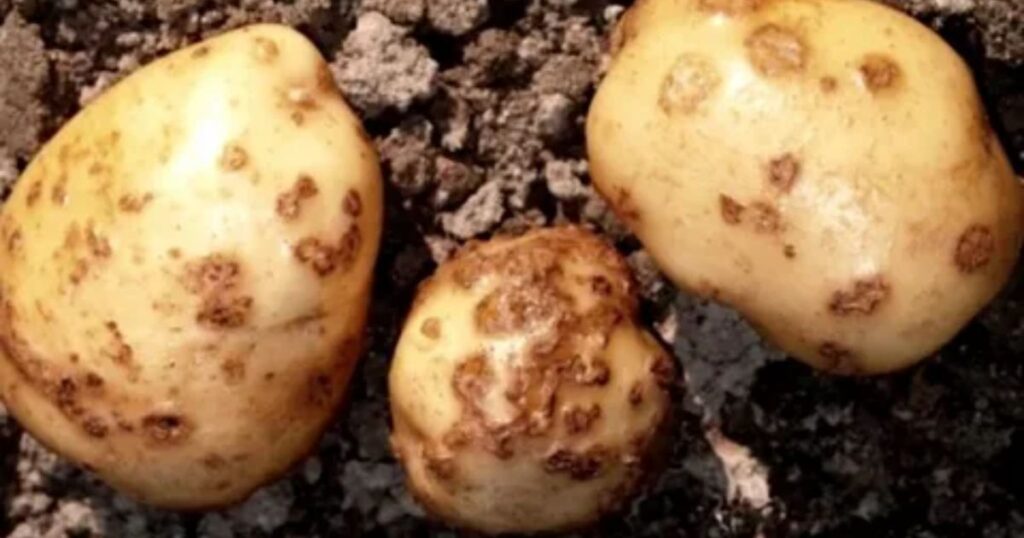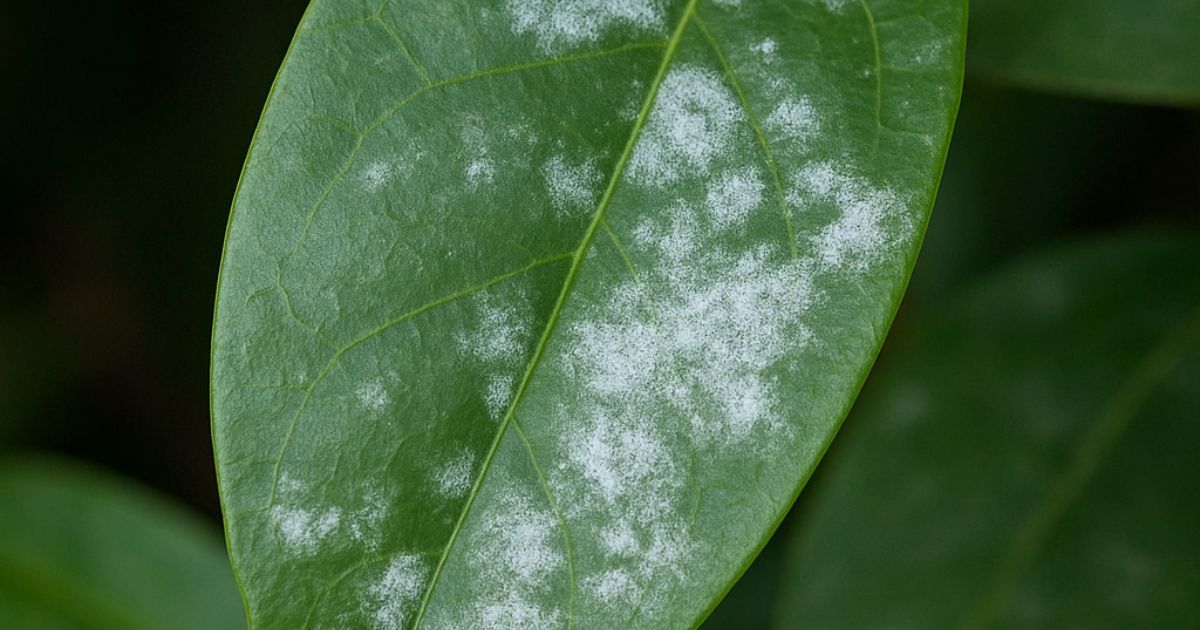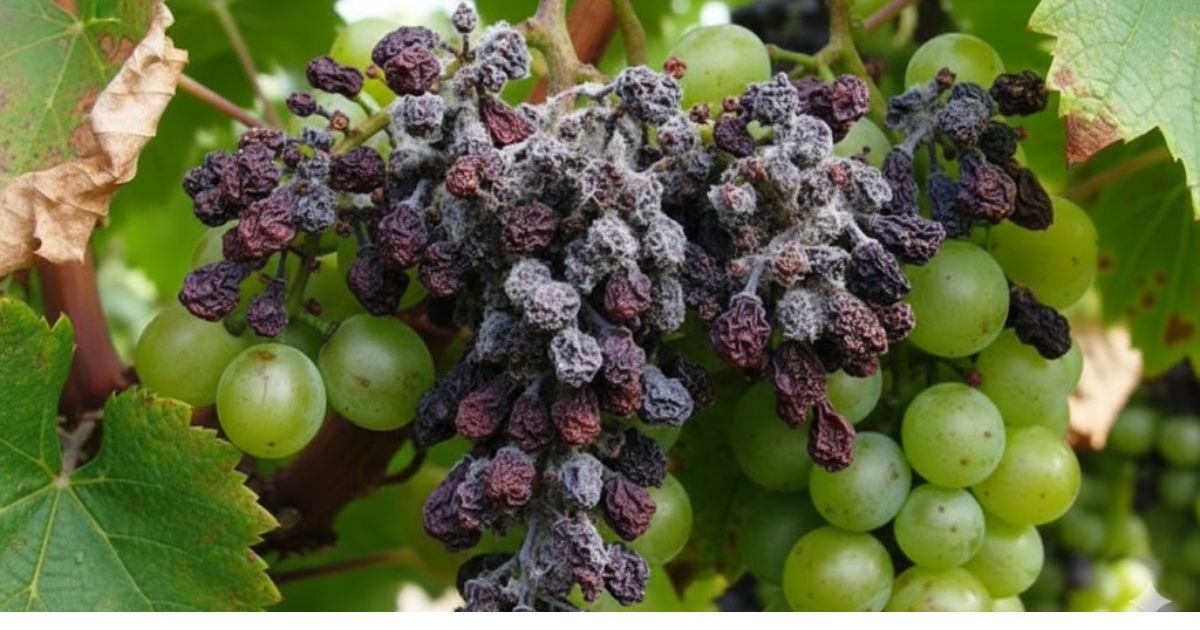Late blight disease is one of the most serious threats to potato crops worldwide. Late blight, caused by the fungus-like organism Phytophthora infestans, can rapidly destroy leaves, stems, and tubers under favorable conditions in just days. This disease was famously responsible for the Irish Potato Famine in the mid-1800s, and it remains a significant challenge for potato farmers today.Late blight thrives in cool, moist environments, making timely prevention essential. Once established, it can devastate an entire crop, leading to significant economic loss. Because the pathogen spreads quickly through spores carried by wind, rain, and infected seed potatoes, farmers must take proactive steps to prevent infection before it starts.
This guide will walk you through everything you need to know about preventing late blight disease of potatoes. You’ll learn how to identify early symptoms, understand the conditions that encourage the disease, and apply proven cultural, biological, and chemical control strategies. These precautions will help you safeguard your potato harvest. Improve yields and reduce the risk of this destructive disease impacting your harvest.
What is Blight in Potatoes?
Blight in potatoes, most commonly late blight, is a severe plant disease caused by the fungus-like microorganism Phytophthora infestans. It attacks the leaves, stems, and tubers of potato plants, leading to rapid crop damage and significant yield loss if not controlled early.
Key characteristics of late blight in potatoes:
- Fast-spreading disease: Under cool, moist conditions, blight can spread quickly, affecting entire fields within days.
- Leaf infection: Initially appears as dark, water-soaked spots on leaves that enlarge rapidly. These spots often have a pale green or brown border and may develop a white, fuzzy growth under moist conditions.
- Stem infection: Dark brown or black lesions form on stems, weakening the plant and making it prone to collapse.
- Tuber infection: Tubers develop firm, dark patches beneath the skin that can rot and spread during storage.
Blight thrives in humid, wet climates and spreads through spores carried by wind, rain, contaminated tools, and infected seed potatoes. Because of its destructive nature, late blight is considered one of the most damaging diseases of potatoes globally.
Proper identification, prevention, and management are essential to protect potato crops from this devastating disease.
Why Are My Potato Plants Turning Yellow?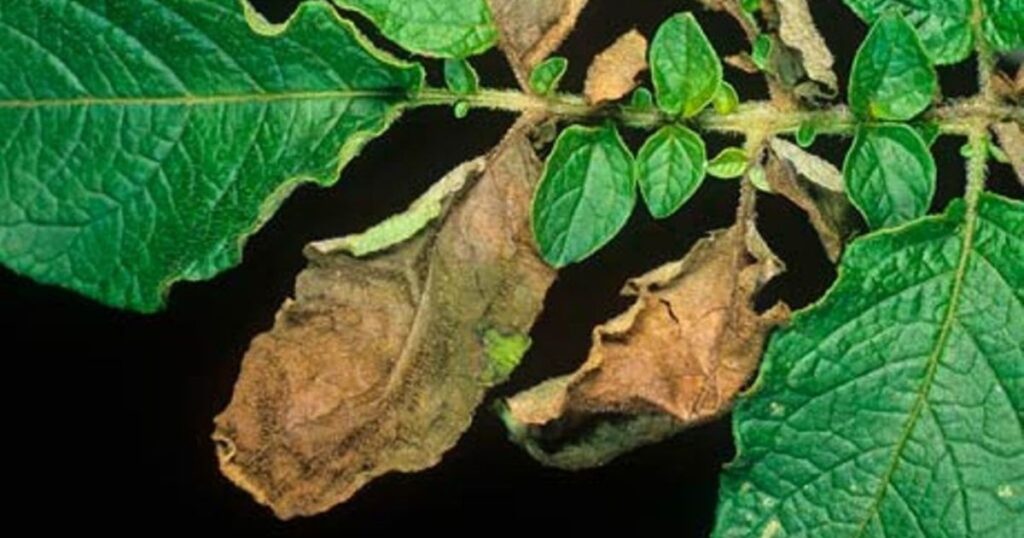
Yellowing potato plants can be caused by several factors, ranging from natural growth cycles to nutrient deficiencies, pests, diseases, or environmental stress. Understanding the cause is key to saving your crop.
Here are the most common reasons:
Natural Aging (Maturation)
Potato plants naturally turn yellow and die back at the end of their growing season. This is normal and indicates the plant is directing energy to tuber development. This typically happens a few weeks before harvest.
Nutrient Deficiency
- Nitrogen deficiency — Causes older leaves to turn pale yellow, slowing growth. Nitrogen is vital for leafy growth.
- Magnesium deficiency — Results in yellowing between leaf veins while veins remain green.
- Potassium deficiency — Can cause yellowing edges and weak stems.
- Correcting these involves soil testing and applying a balanced fertilizer.
Overwatering or Poor Drainage
Potatoes need well-drained soil. Excess water can suffocate roots, How to Treat Camellia Black Spots on Leaves leading to yellowing leaves and root rot. Ensure proper drainage and avoid constant soggy conditions.
Pest Damage
Aphids, leafhoppers, and wireworms can damage potato plants. Aphid infestations, for example, may transmit viruses that cause yellowing.
Disease
Several potato diseases cause yellowing leaves, including:
- Late blight — Dark lesions with yellow halos.
- Early blight — Brown spots with yellow edges.
- Verticillium wilt — Yellowing starts on older leaves and spreads upward.
- Potato virus Y — Causes mottled yellowing and stunted growth.
Environmental Stress
Extreme temperatures, drought, or nutrient-poor soil can stress plants, causing yellow leaves.
Identifying Symptoms of Late Blight in Potatoes
Early detection of late blight is crucial for preventing significant crop losses. This disease, caused by Phytophthora infestans, spreads rapidly under cool, moist conditions and affects the leaves, stems, and tubers of potato plants. Knowing the symptoms allows farmers and gardeners to act quickly before the infection spreads.
Here’s how to identify late blight:
Leaf Symptoms
- Dark, water-soaked spots: Initially appear as irregularly shaped, pale green or brown lesions on leaves.
- Rapid enlargement: Spots quickly grow larger, often merging to form larger blotches.
- Yellow halos: Surrounding the dark spots, a yellow border often forms.
- White fuzzy growth: Under humid or wet conditions, a white, downy fungal growth can appear along the underside of leaves — a classic sign of late blight.
Stem Symptoms
- Dark lesions: Dark brown or black patches develop on stems, How to Fix Cherry Tree Leaves Turning Brown often at leaf nodes.
- Softening of tissue: Infected areas may become mushy or water-soaked.
- Wilting: Severe infections cause stems to collapse and leaves to wilt rapidly.
Tuber Symptoms
- Firm dark patches under skin: Tubers develop irregular dark brown or purplish areas beneath the skin.
- Surface skin blemishes: Infected tubers may have rough, sunken patches.
- Rot: As infection progresses, tubers can rot completely, producing a foul odor.
Rapid Spread
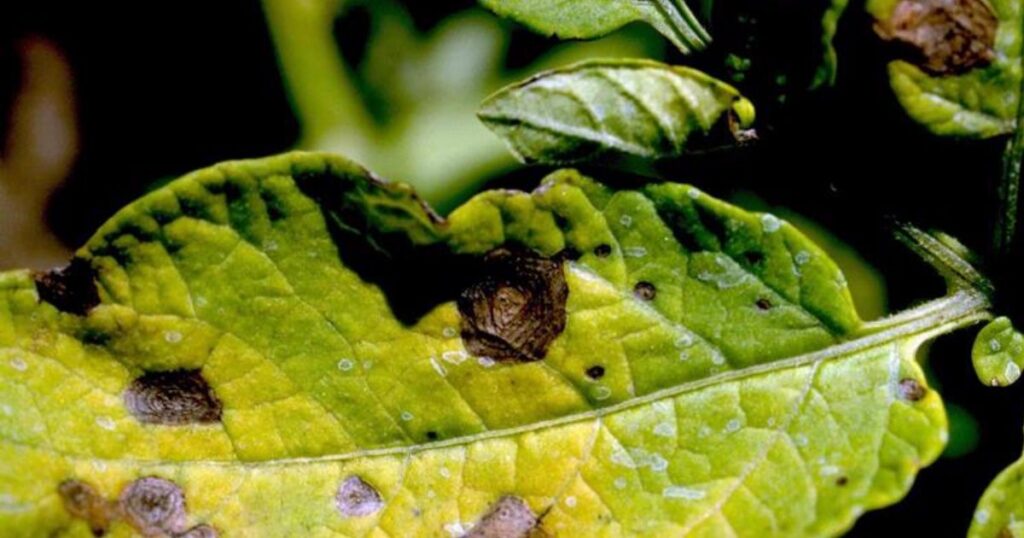
Late blight spreads quickly. Under ideal conditions (cool temperatures and high humidity), symptoms can appear within days of infection, affecting large portions of the crop in a short time.
Causes and Contributing Factors of Late Blight in Potatoes
One of the most damaging diseases affecting potatoes globally is late blight, which is brought on by the pathogen Phytophthora infestans. Recognizing the reasons and elements that lead to its effective prevention and control.
Here are the leading causes and contributing factors:
Favorable Weather Conditions
- Late blight thrives in cool, moist environments.
- Ideal conditions include temperatures between 10°C–20°C (50°F–68°F) combined with high humidity or frequent rainfall.
- Wet leaves, dew, or prolonged leaf wetness provide perfect What Are Basil Black Spots and How Can You Eliminate Them? conditions for spore germination and disease spread.
Infected Seed Potatoes
- Using infected seed potatoes is one of the most common causes of late blight outbreaks.
- Even a small amount of infected material can introduce the pathogen into a whole crop.
- Certified disease-free seed potatoes significantly reduce this risk.
Spread Through Spores
- Late blight spreads quickly through airborne spores.
- Spores can travel long distances, Top Tips for Winter Vegetable Storage carried by wind and rain, infecting nearby potato crops and even tomato plants.
Poor Crop Management
- Planting potatoes in the same location year after year increases disease risk due to soilborne spores.
- Dense planting reduces airflow, creating moist environments ideal for late blight.
- Overhead irrigation can keep leaves wet for long periods, encouraging fungal growth.
Presence of Volunteer Potato Plants
- Volunteer potatoes (plants that grow from leftover tubers in the soil) can harbor the disease and act as a reservoir for late blight spores in the following seasons.
Weakened Plants
- Plants stressed by nutrient deficiencies, poor soil conditions, drought, or pest damage are more vulnerable to late blight infection.
Best Practices for Preventing Late Blight in Potatoes
Preventing late blight (Phytophthora infestans) is far easier and more cost-effective than trying to control it once it spreads. Combining cultural, biological, and chemical methods is the most effective approach to protect your potato crop.
Here are the key prevention strategies:
Use Certified, Disease-Free Seed Potatoes
- Purchase certified seed potatoes from reputable suppliers.
- Avoid using saved tubers from a previous harvest, especially if disease was present.
- Inspect seed potatoes before planting — discard any showing signs of blemishes, spots, or rot.
Practice Crop Rotation
- Don’t plant tomatoes (or potatoes) in the same spot every year.
- Rotate crops every 2–3 years to reduce the buildup of late blight spores in the soil.
- Use non-host crops (such as legumes or cereals) to break the disease cycle.
Maintain Proper Plant Spacing
- Space plants adequately to improve air circulation around foliage.
- Proper spacing helps leaves dry quickly after rain or irrigation, reducing the time conditions are ideal for blight development.
Manage Irrigation Carefully
- Avoid overhead irrigation that keeps leaves wet for long periods.
- Watering near the plant’s base or using drip irrigation minimizes foliage wetness and lowers disease risk.
- Water early in the day so foliage dries before evening.
Remove and Destroy Infected Plant Material
- Promptly remove diseased leaves, stems, or tubers.
- Burn or bury contaminated plant debris far away instead of composting it. What is Damping Off Disease and How to Protect Your Seedlings From potato fields to prevent spore spread.
Control Volunteer Potatoes and Weeds
- Remove volunteer potato plants from fields as they can act as reservoirs for late blight spores.
- Keep the field and surrounding areas free of weeds that can harbor disease.
Monitor Weather and Crops Regularly
- Watch for periods of high humidity and cool weather, which increase late blight risk.
- Inspect potato plants weekly for early symptoms, especially during rainy seasons.
Why Potato Plant Leaves Are Turning Brown
Brown leaves on potato plants can signal a variety of issues late blight disease in potato from natural aging to diseases, nutrient problems, or environmental stress. Understanding the cause is essential to protect your crop and maintain healthy growth.
Here are the most common reasons:
Natural Maturity
Potato plants naturally turn yellow or brown and die back toward the end of their growing season. This is normal and indicates the plant is redirecting energy into tuber development. This usually happens a few weeks before harvest.
Late Blight
One of the most dangerous causes of browning leaves in potatoes is late blight (Phytophthora infestans).
- Symptoms: Dark brown or black water-soaked patches on leaves, often surrounded by a yellow halo.
- In humid conditions, a white fuzzy growth may appear on the underside of leaves.
- Rapid spread can destroy foliage within days.
Early Blight
Caused by the fungus Alternaria solani, early blight produces:
- Small dark spots on older leaves.
- Yellowing between the spots, eventually turning leaves brown.
- A pattern that starts from older leaves and moves upward.
Nutrient Deficiencies
- Nitrogen deficiency: Older leaves turn pale yellow to brown.
- Potassium deficiency: Brown edges or spots on leaves, reduced growth.
- Magnesium deficiency: Yellowing between veins with brown patches.
Environmental Stress
- Excessive heat or drought can cause leaves to turn brown and dry out.
- Overwatering or poor drainage can suffocate roots and cause browning leaves.
Pest Damage
Aphids, leafhoppers, and other pests can damage potato leaves, transmitting diseases that cause browning.
How to Prevent Potato Blight
Potato blight, especially late blight caused by Phytophthora infestans, is a devastating disease that can wipe out entire crops in days if not managed early. potato plant diseases and pests Prevention is far more effective than trying to control the disease after infection. A mix of resistant cultivars, cultural customs, and careful monitoring is the best defense.
Here’s how to prevent potato blight:
Use Certified, Disease-Free Seed Potatoes
- Always buy certified seed potatoes from reputable suppliers.
- Avoid replanting tubers from infected crops; even minor infections can spread rapidly.
- Inspect seed potatoes before planting; discard any with blemishes, soft spots, or rot.
Practice Crop Rotation
- Avoid planting potatoes or other susceptible crops (like tomatoes) in the same spot year after year.
- Rotate crops every 2–3 years to break the disease cycle.
- Plant non-host crops (e.g., legumes, cereals) between potato crops.
Choose Resistant Varieties
- Select potato varieties bred for late blight resistance.
- Resistant varieties significantly reduce risk and limit spread.
- Examples include varieties like ‘Cara,’ ‘Sarpo Mira,’ and ‘Valor’ (availability depends on your region).
Ensure Proper Spacing and Airflow
- Space plants adequately to prevent overcrowding.
- Good airflow helps leaves dry quickly, reducing the moisture that blight spores need to grow.
Manage Irrigation Carefully
- Avoid overhead irrigation that keeps foliage wet for long periods.
- Water early in the day so foliage dries before evening.
- Use drip or furrow irrigation to minimize leaf wetness.
Remove and Destroy Infected Material
- Regularly inspect plants and remove infected leaves immediately.
- Do not compost infected material; burn it or bury it away from potato fields.
Control Volunteer Potatoes and Weeds
- Volunteer potato plants can harbor late blight spores and spread disease to new crops.
- Keep fields and surrounding areas weed-free.
Monitor Weather and Crops
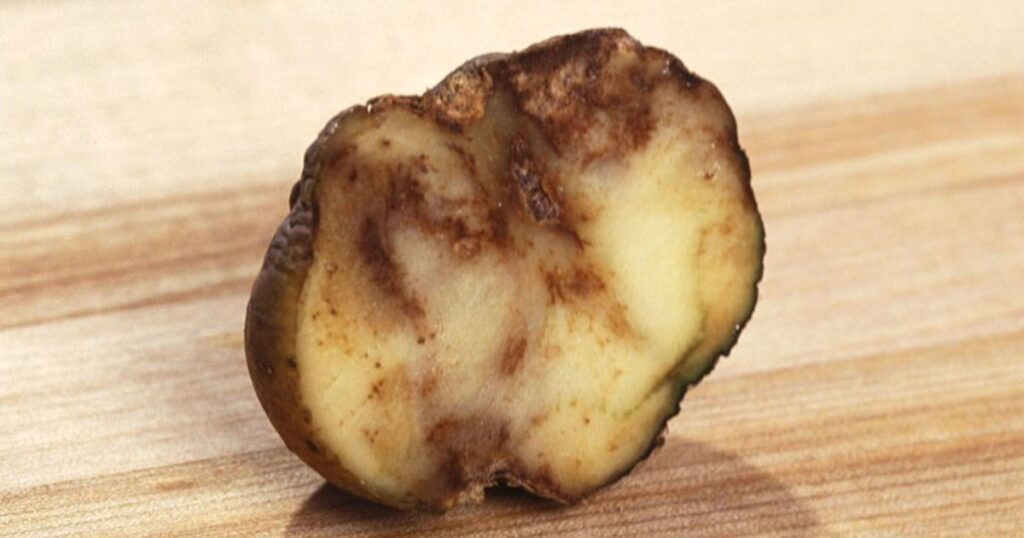
- Late blight thrives in cool, wet conditions.
- Monitor weather forecasts and inspect crops during high-risk periods.
- Early detection allows rapid action before the disease spreads.
Conclusion
One of the biggest dangers to potato crops globally is late blight. It is capable of causing devastating losses in just days under favorable conditions. However, with proper knowledge and proactive measures, it is possible to prevent or significantly reduce its impact. Prevention is more important than treatment. Starting with certified disease-free seed potatoes, practicing crop rotation, choosing resistant varieties, maintaining proper spacing, and managing irrigation carefully.Regular monitoring of potato plants, especially during cool, wet weather, is essential for early detection. Prompt removal and safe disposal of infected material can stop the disease before it spreads. Combining cultural practices with resistant varieties and, when necessary, safe chemical or biological controls creates a strong, sustainable defense against late blight.
Farmers and gardeners may protect their crops by adhering to these best practices. Their potato crops ensure healthy plants, higher yields, and a reliable harvest season after season. Prevention is not just about protecting a single crop; it’s about maintaining healthy soil, preserving resources, and securing the future of potato farming.A proactive, informed approach to potato blight is the best investment you can make for a healthy, productive crop.
FAQ
What is the best fungicide for preventing late blight?
Fungicide choice depends on your location and regulations. Standard options include copper-based fungicides and products containing chlorothalonil or mancozeb. To avoid resistance, rotate fungicides and always adhere to label directions.
Can late blight spread from potatoes to tomatoes?
Yes. Late blight affects both potatoes and tomatoes. Planting them close together can increase the risk of disease spread. Rotate crops and maintain proper spacing to minimize risk.
How can I tell if my potato plants have late blight?
Look for irregular dark brown or black lesions on leaves, often with yellow halos, and a white fuzzy growth under moist conditions. Stems may have dark lesions, and tubers may develop firm dark patches under the skin.
How often should I inspect my potato plants for late blight?
During cool, wet weather, which is ideal for late blight, it is advisable to inspect plants at least twice a week. In dry conditions, inspections can be less frequent but should still be part of regular maintenance.
Is late blight preventable organically?
Yes. Organic prevention focuses on crop rotation, planting resistant varieties, proper spacing, and using organic fungicides such as copper sprays or biological products like Bacillus subtilis. Good cultural practices remain the most effective organic defense.
How long after infection can late blight destroy a potato crop?
Under ideal conditions for the pathogen, late blight can destroy an entire potato crop in as little as 7–10 days. Early detection and quick action are critical to stopping its spread.

